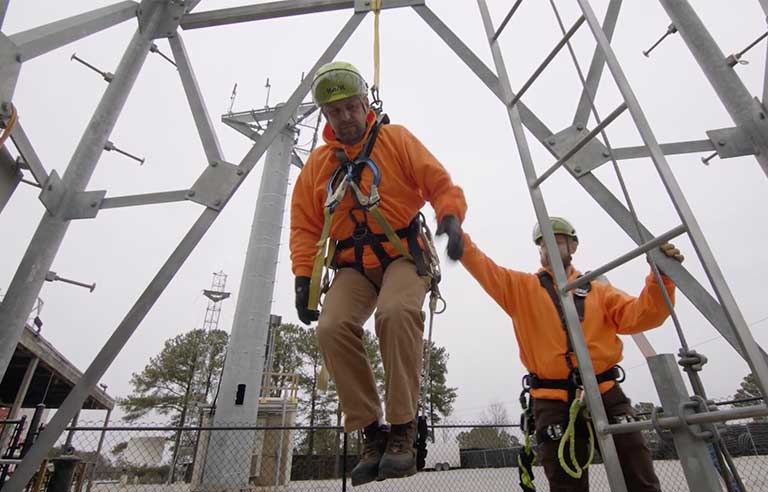
Photo: NATE: The Communications Infrastructure Contractors Association.
First published by Safety+Health an NSC publication.
Watertown, SD — Proper rescue planning for suspension trauma incidents at tower sites is the focus of a new video from NATE: The Communications Infrastructure Contractors Association.
Suspension trauma, also known as orthostatic intolerance, can occur when a tower worker falls and remains suspended in a harness after his or her fall arrest system activates. The body may go into shock as a result of a disruption in blood flow, which may lead to unconsciousness and even death. Warning signs of suspension trauma are related to those associated with shock: pale complexion, feeling faint, sweating, leg numbness, nausea, dizziness and confusion.
Acting quickly is critical. If a climber notices signs of suspension trauma in a fellow climber and the worker is conscious, longtime rescue trainer Brian Horner advises getting the climber to move his or her legs to keep blood flowing. Ask the individual how he or she is doing, put the suspended climber in a horizontal position, and begin to safely lower him or her to the ground, seeking help from additional climbers if necessary.
If the individual is unconscious, however, “that’s where everything changes,” Horner said. “Everything now has got to be expedited, whether it be an airway, whether it be extrication, whether it be lowering. In fact, this guy now is a cardiac patient. The best treatment for this worker is down there,” Horner added, pointing to the ground.
Once a climber suffering from suspension trauma is lowered to the ground, employers or workers should call 911 and lay the individual flat to stabilize him or her. Then, if the climber is unconscious, place the patient on his or her left side to reduce vomiting, and wait for help to arrive.
Horner encourages industry workers and employers to view the video and “proactively pursue” additional training, education and research related to suspension trauma.
The video is the most recent installment in NATE’s Climber Connection series, which promotes safe work practices for communication tower workers. The association asks climbers and other industry stakeholders to use the hashtag #ClimberConnection when posting the video on social media platforms.
McCraren Compliance assists employers in protecting their workers, starting with a comprehensive Work-site Analysis, Hazard Prevention, Controls, and Safety & Health Training.
Please contact us today at 888-758-4757 to learn how we can provide mine safety training and consulting for your business.


